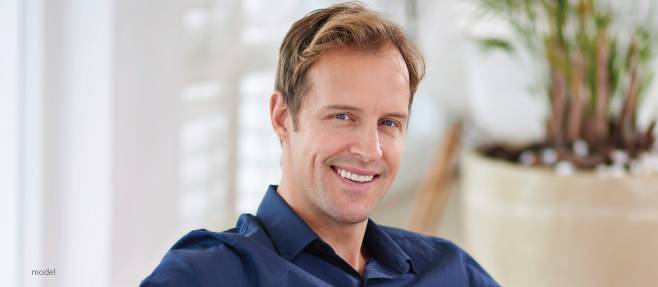Male Pattern Baldness: Causes, Symptoms, and Treatments

Hair loss has long been one of the most prevalent aging problems among men. Male pattern baldness (androgenic alopecia) is very common, with U.S. National Library of Medicine estimating that it affects 50 million men in the United States.
While male pattern baldness can vary from individual to individual, the typical pattern begins with hair loss in a well-defined pattern above both temples. The pattern proceeds to become more defined, to the point where the hairline recedes making an “M” shape. Over time the hair becomes thinner and shorter and recedes at the crown (near the top of head) resulting in partial or complete baldness.
The Primary Cause of Male Pattern Hair Loss
Male pattern baldness is caused by an individual’s genetics and hormones. Years of research show the genetic inheritance of factors result in the overproduction of androgen, a male sex hormone responsible for regulating hair growth.
Normal hair growth occurs in a natural cycle within follicles located under the skin. Hair grows for between 2-6 years before going into a resting phase for several months and then falling out. At this point the cycle starts over again with new hair growing within the follicle.
Increased androgen levels disrupt normal hair growth by shortening the natural cycle, shrinking hair follicles, and producing finer strands of hair. Additionally androgens can cause a delay in the growth of new hair to replace shed strands. Eventually the hair growth cycle completely ends so no new hair can regrow in bald areas.
Topical Treatments
The first action that patients typically take against hair loss is treatment with finasteride (Propecia) or minoxidil (Rogaine). These treatments are clinically proven to slow the hair loss process and even help to regrow new hair. The results are only effective while the treatment plan is continued.
Proplasma Hair Restoration
ProPlasma™ is a non-surgical treatment that helps restore hair in patients with hair thinning issues or pattern hair loss. Learn more about Proplasma Hair Restoration
Hair Transplant Surgery
The only permanent solution for hair loss is hair transplant surgery. There are several types of techniques available, the most common of which is referred to as “strip harvesting”. Using this method, the physician excises a strip of hair-bearing tissue from the posterior scalp in order to harvest hair and follicles for transplant to the treatment area. The surgeon uses very small micro-blades to insert the grafts (groupings of hair follicles) in predetermined spots to promote a realistic hair pattern.
If you are experiencing hair loss, the first step is to schedule a visit with your dermatologist to learn what treatment is best suited for your needs.

I’m very interested in proplasma, ive never heard of such a treatment.
Good post and right to the point. Thank you 🙂
Consuming Nettle Roots & Pygeum are one of the best home remedies to treat male pattern baldness.